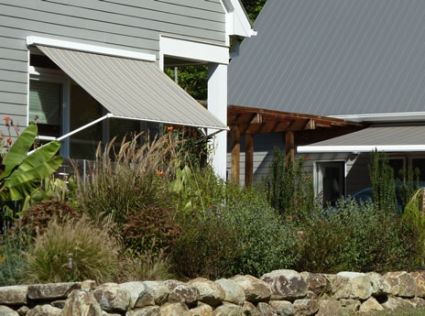Overview - Deciding What to Do With Existing Windows
Description
Windows play vital roles in our homes: bringing in natural light, connecting us visually with the outdoors, providing fresh air during warm months, helping to slow down heat loss, controlling unwanted temperature increases from sunlight (solar heat gain), and contributing to overall appearance. Balancing these attributes can be complex because some conflict with others; for example, a feature that optimally blocks unwanted summer heat gain may negatively affect views, daylighting, and beneficial solar heat gain in the winter.
Windows’ impact on energy consumption is huge. In older homes, windows typically account for 25% of annual heating and cooling costs but can be responsible for as much as 40%. In new construction, a homeowner can easily minimize windows’ energy impacts by choosing highly energy-efficient products.
But what should be done about existing windows?
This fact sheet lays out a process for evaluating existing windows and deciding among a wide range of options for either replacing windows or retrofitting them with interior or exterior coverings, or attachments, depending on the particular situation and needs.
Names and Parts of a Typical Window
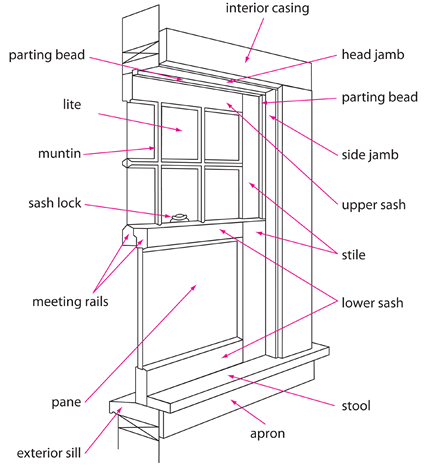
Do Windows Need to Be Replaced?
The first step in deciding how to address existing windows in a home is to evaluate their condition. If the windows are in poor shape, the best course of action may be to replace them with new high-performance windows. The difference in price between standard and “high-performance” replacement windows with low-emissivity (low-e) coatings and gas fill will, in most cases, be quickly paid back through energy savings. In colder climates, triple-glazed replacement windows with two low-e coatings may be justified.
Windows are Good Candidates for Replacement if:
- Wooden frames are rotted or decayed.
- Windows are extremely leaky and weatherstripping is not practical.
- Aluminum or vinyl sashes are broken, cracked, or out of square.
- Sliding or hinged sashes can no longer be operated because of failed tracks or mechanisms.
- Seals on insulated glass panels have failed, as evidenced by condensation or fogging between the panes of glass.
- Wooden frames and sashes are covered with lead paint that is subject to abrasion.
The Efficient Windows Collaborative is the best source for information on window replacement.
If windows are in good shape, it’s often hard to justify the cost of replacement, and one or more of the window coverings described in this series of U.S. Department of Energy (DOE) fact sheets may be a better investment. The other fact sheets in the Window Coverings series recommend options based on the assumption that the homeowner has decided to keep existing windows.
Terminology
Spectrally selective means transparent to some wavelengths of the solar spectrum and reflective to others. Typical spectrally selective coatings are transparent to visible light and reflect short-wave and long-wave infrared as well as UV radiation. Spectral selectivity can be achieved with low-e coatings and/or high-performance tints.
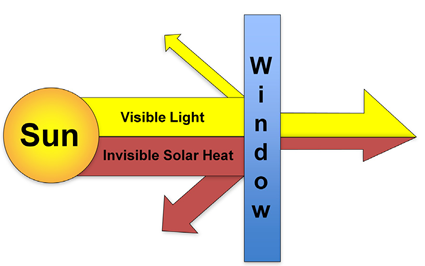
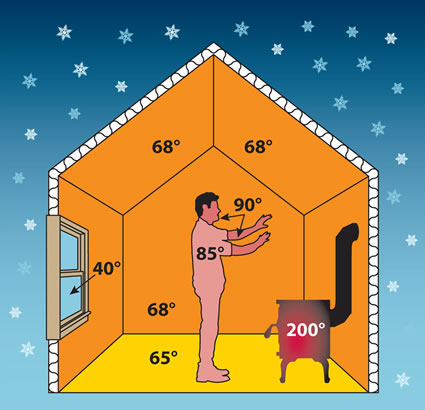
Mean radiant temperature (MRT) is roughly the average temperature of all the objects or surfaces in a space. The temperature contribution of each individual surface is weighted by its area, spatial relationship, and temperature difference from the skin temperature of a person in the space. An MRT that is warmer than the skin temperature of a person will cause the person to feel warmer, and an MRT that is colder than the skin temperature of a person in the room will cause that person to feel colder. MRT and air temperature are the two most important factors in assessing thermal comfort.
What are Window Coverings?
Window coverings are elements added to existing windows to improve energy performance, reduce glare, provide privacy, or enhance the appearance or comfort of a home. Window coverings include: interior shades and drapes, plastic films applied directly to the glass, exterior shades, shutters, awnings, and storm windows.
Deciding Among Various Window Covering Options
In considering the various options for window coverings, it is important to understand how these treatments can affect window properties and performance. The attributes described below are keyed to a summary table at the end of this fact sheet.
Thermal Performance and Ventilation
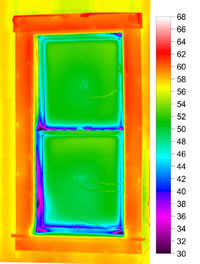
For the existing Window Covering selection tool, a team of industry members and window/window covering researchers used a consensus process to qualitatively and comparatively eveluate window covering performance. This qualitative tool will soon be augmented by a quantitative selection tool, using industry-leading simulation software to predict or comparatively evaluate diffferent window coverings based on a standard home and for a variety of climates.
Photo credit (infrared image): LBNL/BuildingGreen
Insulation
The degree of insulation a window provides is a major determinant of the window’s overall thermal performance. Window retrofits can boost window insulation by adding layers of glazing, coatings that reduce radiant heat loss, and even moveable insulation panels.
Air tightness
Air leakage through windows is another major determinant of overall window thermal performance, particularly in cold climates. Some window attachments improve airtightness by reducing air leakage.
Solar heat gain
Many window coverings add significant solar heat gain control; they can be selected and adjusted depending on whether heat gain is desired or not.
Comfort – Winter
The thermal comfort provided by windows is a function of air leakage, surface temperature, and solar heat gain. During cold weather, some window coverings improve comfort by reducing air leakage and keeping the window surface facing the room warmer.
Comfort – Summer
During hot weather, some window coverings improve comfort by controlling solar heat gain and keeping the innermost window surface cooler. Spectrally-selective glazing or coatings can improve the insulation, winter thermal comfort, and summer thermal comfort performance of many window covering options.
Condensation
When warm indoor air comes in contact with cold window surfaces, condensation can result. Window coverings can prevent or reduce condensation by keeping the window’s interior surface warmer. However, some can increase condensation problems by either decreasing the temperature of surfaces that are in contact with warm, moist interior air, or by making the home more airtight and reducing the amount of dry, outdoor winter air leaking into the home.
Ventilation
Some window coverings, such as low-e storm windows with integral screens, facilitate the use of windows for ventilation; others can impede airflow through otherwise operable windows.
Getting the best performance from your windows may involve both an interior and an exterior attachment. Note the interior shades and exterior awning serving this set of windows.
Photo: Glen Raven
Visual performance
View
Home occupants may perceive the view from a window as essential or unwanted, depending on what is outside the window. Window coverings can affect view temporarily or permanently. For example, window coverings such as shades and drapes can adjust to allow or block view while options such as fixed awnings may always block a portion of the view.
Daylighting
Windows provide natural lighting during the day, and some window coverings can increase or decrease daylighting. Any attachment that shades a window will reduce daylighting, whereas devices that redirect light, such as venetian blinds,
can help to extend daylight deeper into a room.
Glare
Operable attachments, such as interior blinds and drapes, allow occupants to control glare. Exterior awnings control glare by shading windows. Applied films permanently reduce glare by tinting the glass.
Privacy
Windows not only provide views to the outdoors but also provide views into a house from outside, which may not always be desirable. Operable window retrofits, such as blinds and drapes, offer excellent privacy on demand.
Economics
 The National Fenestration Rating Council (NFRC) provides rating and certification for only one class of attachment products, applied films. DOE is supporting the effort to develop a rating system for all types of window coverings and, with EPA, is exploring the development of an EnergyStar program for window attachments. NFRC
The National Fenestration Rating Council (NFRC) provides rating and certification for only one class of attachment products, applied films. DOE is supporting the effort to develop a rating system for all types of window coverings and, with EPA, is exploring the development of an EnergyStar program for window attachments. NFRCProduct cost
Product cost can range from as little as $15 per window for a single-attribute attachment to as much as $500 per window for a sensor-driven, motorized attachment that addresses several aspects of the window’s overall performance.
Installation cost
For window coverings that must be professionally installed, quoted prices usually include installation. Other options offer significant savings for do-it-yourselfers.
Durability and service life
How long a window attachment lasts affects its total (life-cycle) cost. Warranties can be a proxy for durability, particularly if the warranty is for a specific number of years rather than "lifetime" (unless the lifetime warranty is transferable). Reparability is an important element of service life for operable attachments and motorized components.
Other uses and functions
Adjustability
There are a lot different ways to adjust window attachments: raising and lowering blinds; tilting louvers; opening and closing sashes. Even if a window covering is motorized, adjustability is both a feature and a responsibility. Automated window coverings, on the other hand, combine motorization with sensors, timers, or programming that can optimize operation without requiring occupant engagement.
Window protection
Some window coverings protect windows from the elements (wind, rain, and ultraviolet radiation). Other measures can increase thermal stress by trapping heat between layers of glass or between glass and an insulated interior window treatment.
Noise control
Some window coverings can help to control noise, an important attribute for a home on a busy city street, for example. However, noise reduction is highly dependent on the airtightness of the window and any attachment.
Egress
Using windows as emergency exits can be desirable or essential. Some window attachments make exiting very difficult, others may pose a minor inconvenience, and others have no impact on egress.
Security
Window treatments such as applied window films can make it much harder to break into a house, and rugged exterior roller blinds often provide security as a primary function.
A Survey of Window Coverings
The chart below lists the major types of window coverings and rates them for the attributes described above (Note table legend at upper left). One way to use the summary chart is to choose the feature (column) you think is most important, and look down the column to see which options (rows) are rated best for this feature.
For example, if you choose the first column, insulation, you can easily pick out the retrofits that have the highest rating (darkened circle). You can then compare the products that have the highest rating for this feature to the most highly rated products for another feature of importance. For example, roller shutters are highly rated for both insulation and security.

